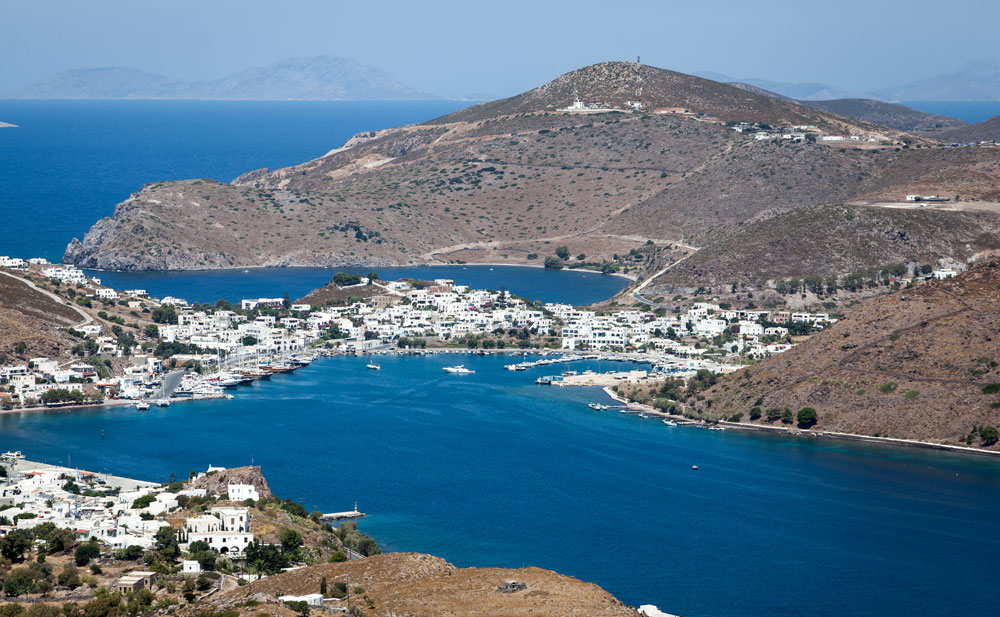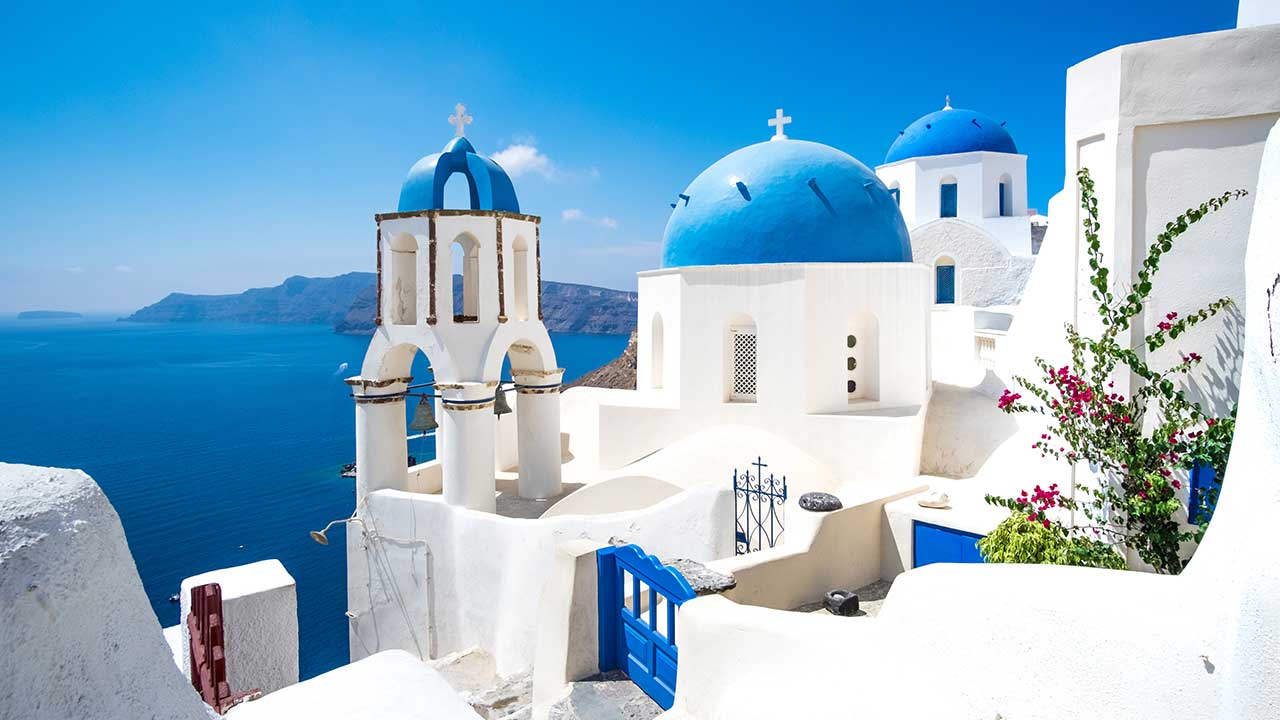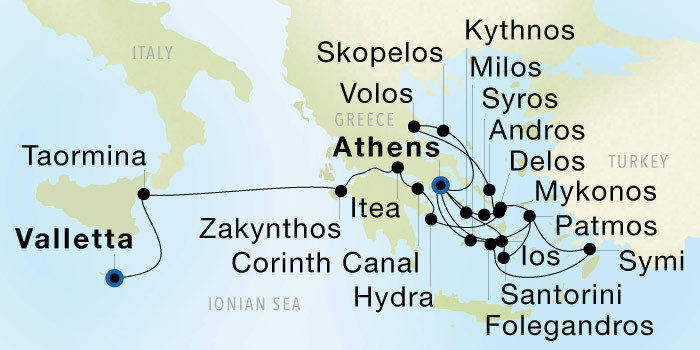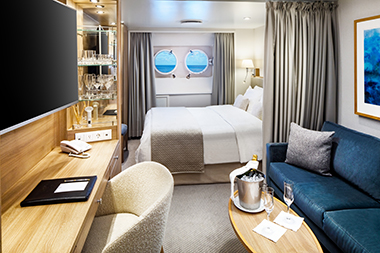
Piraeus, roughly translating to “the place over the passage”, is an important Greek port located within the Athens agglomeration, in the Attica Basin. It is 12 kilometers from the municipality of Athens, considered the fourth largest and is the third most populous amongst all the municipalities of Greece. Now a peninsula, Piraeus, originally a rocky island, was developed in early 5th Century B.C. when it was initially designated as Athens’ import and transit trade port. It is the largest marine-based shipping center of Greece, one of the largest ports in Europe, and considered the second largest passenger port in the world. Inhabited since the 26th Century, it wasn’t until the 6th Century B.C. that Piraeus began catching attention. The land of Piraeus was essentially impassable, flooded by the sea most of the year until centuries passed and the flooding ceased. By the 5th Century B.C. it became a navy base for the Athenian fleet for the natural harbors and the strategic potential they carried. Athenian general and politician Themistocles fortified Piraeus’ three harbors Kantharos, Zea and Munichia, created ship houses and completed his walls in 471 B.C., which led to the port becoming a great military and commercial harbor. There are many archaeological sites, points of interest and entertainment available in Piraeus. Most famous for its tavernas and cuisine, several popular events take place in Piraeus, such as the Ecocinema International Film Festival, the Maritime Festival, the Piraeus Rock Wave Festival and the Three Kings’ Way Festival. There are also many theaters, including the Municipal Theater, the open air Veakeio Theater, and the Menandreio Theater. Museums in Piraeus include the Archaeological Museum of Piraeus, the Merchant Shipping History Institute Exhibition, the Panos Aravantinos Decor Museum, the Georgios Averof Museum Ship and the Museum of Electric Railways. Be sure to catch the panoramic views available from the hill of Kastella, overlooking Athens and the Saronic Gulf!

Tucked away in the western Aegean Sea, Skopelos is one of the lushest Greek islands of the Sporades island group, with pine forests that grow densely to the water’s edge and seemingly reach into the sea. Boasting dozens of picturesque, white-sand beaches and quintessential Greek villages, Skopelos sings with beauty. Most of the outdoor scenes in Mamma Mia were filmed on location at the island’s beaches and small towns. Weather permitting, we will sail by the headland with the wedding chapel shown in the movie.

Volos lies at the foot of Mt. Pelion with its forests and traditional villages. We dock on the bustling waterfront to offer our guests the opportunity to visit the incredible Monasteries of Meteora. You know the ones featured in the James Bond film "For Your Eyes Only". This is a “must do” opportunity. Meteora is one of the most imposing sights in mainland Greece. Giant rocks in bizarre shapes, ranging in height from 100 to 150 meters with monasteries built on top of these interesting 14th century formations. Volos itself is one of the largest and most attractive cities in Greece as well as one of the country’s most prominent ports.


Sitting pretty at only a little over one square mile and largely uninhabited, Delos was considered “the most sacred of all islands” in ancient Greek culture. Legend has it that this is the location where Apollo, god of daylight, and his twin sister Artemis, goddess of night light, were born. The UNESCO World Heritage site is by far one of the most important archaeological and historical sites in Greece. Indeed, its location at the center of the Cyclades gives rise to the theory that the name of the Cyclades group of islands comes from the word “circle,” or kyklos, that form around the isle of Delos. Most day visitors access this storied port by ferry; SeaDream will anchor offshore for maximum exploration.

Mykonos is one of the most visited Greek Islands. It is part of the Cyclades group and lies between Tinos, Syros, Paros and Naxos. The island spans an area of 85.5 square kilometers (33.0 sq mi) and rises to an elevation of 341 meters (1,119 feet) at its highest point. Mykonos is so incredibly beautiful; it is not surprising that it has become one of the most desired destinations in the world. When you also add the cosmopolitan lifestyle, the sophisticated nightlife and the historical treasures of the nearby UNESCO Awarded Delos you’ll have the recipe for an unforgettable holiday. SeaDream usually anchors just of the famous windmills and tenders directly to the old town. Guests have a few organized options including the Sacred Island of Delos. Others may simply want to explore the island’s incredible beaches, boutiques, clubs and churches independently.

Patmos is in the South Aegean Islands, particularly a member of the Dodecanese Islands of Greece. It is north of Leros and is most known for its connection to John the Apostle from the Book of Revelations; therefore Christian pilgrims frequent this destination. In mythology, Patmos was named “Letois”, which is another named for the goddess Diana, Leto’s daughter. Since ancient authors seldom mention Patmos in early text, information on early inhabitants is limited. It is widely believed the original people of Patmos were the Carians from Asia Minor, as discovered by the earliest archaeological findings date back to the Bronze and Mycenaean periods. The mountain in the country of Caria was named Latmos, which is where historians believe the name Patmos is derived from. Dorians also colonized in Patmos, and over time, Ionians followed suit. The primary port in Patmos is Skala, which was one of the most important sea ports in the Mediterranean around the 16th century. Early Christian basilicas were constructed in the name of John of Patmos, however between the 7th and 9th century when Saracen attacks were still problematic, the Grand Royal Basilica was destroyed. A monastery began construction in 1101 when Christodoulos assumed authority over Patmos. The population began expanding as immigrants from the fall of Constantinople and Candia to place in the 15th and 17th centuries, respectively. The island was under the Ottoman rule for years and was interrupted by Venice during the Candian War, Russia during the Orlov Revolt, and Greece during their War of Independence. During the Italo-Turkish War, Italy occupied Patmos until 1943, when Nazi Germany held power over the island until 1945. Since Patmos rejoined in 1948, it has become the tranquil and frequented destination it is now. Tourists visit the Monastery of St. John, Chora, the Cave of Apocalypse, Psili Ammos Beach and other beautiful points of interest in “Europe’s most idyllic place to live,” as named by Forbes in 2009.

A wild natural landscape of exotic beaches nestled in the western Cyclades, Kythnos is an island of elegant simplicity and hospitality. Steeped in mythology, the island is named after Kythnos, the mythical king of the original settlers and son of the god Apollo. Bisected by ancient walls, lush valleys, and more than 100 secluded beaches, the main town of Hora and its surrounding villages shine for their elegant architecture and strollable alleyways dotted with fountains, flowers, and cozy taverns. Making its maiden call to the island in 2025, SeaDream will anchor off breathtaking Kolona Beach, a unique isthmus beach sitting between two breathtakingly beautiful bays.

A Greek island in the Cyclades group in the Aegean Sea, Ios lies halfway between Naxos and Santorini. A hilly island with cliffs down to the sea on most sides, Ios shines for its amazing beaches, shimmering waters, and picturesque clifftop villages with narrow alleyways. Assessable by ferry or yacht, Ios is within hand’s reach of several Greek islands, including Mykonos, Naxos, Paros, and Crete. Ancient sites, museums, windmills, and churches dot the island, most notably the whitewashed church of Panagia Gremiotissa above Chora, the tomb of the Greek poet Homer in Plakoto, and the early Bronze Age settlement of Sharkos. The Archaeological Museum of Ios, displaying findings unearthed on the island, is housed in the Amiradakio Hall, located in the center of Chora.

Santorini, officially named Thira, is the southernmost Greek island that is within the Cyclades archipelago, in the southern Aegean Sea. Part of the regional unit Thira, the municipality of Santorini is comprised of the island Santorini, Therasia, and other uninhabited islands of Christiana, Palaia Kameni, Aspronisi, and Nea Kameni. The geological history of Santorini is quite complex due to the area’s volcanism and is currently a water-filled caldera: a rectangular lagoon that is surrounded by three steep cliffs. The name Santorini is a contraction of the name Santa Irini, which is based on an ancient cathedral found in the island’s village of Perissa. This name was given by the Latin Empire in the 13th Century. During the Ottoman Empire, Santorini was called “Santurin” or “Santoron”, and in early times, it was named Kalliste, Strongyle, and Thera. Santorini is the site of the Minoan Eruption (also known as the Thera Eruption), one of the largest eruptions ever in recorded history. The origins of Plato’s story of Atlantis is believed to have a connection to this eruption that destroyed the early settlements on what was formerly a single island. The descriptions found of Plato’s Atlantis strongly resembles Thera, and with seismological, archaeological, and volcanological evidence, these claims are further supported. There is also speculation that the eruption is related to the Exodus of the Israelites, as well as causing the plagues described in the Bible in ancient Egypt. The economy is sustained by two principal industries: tourism and agriculture, and has recently been voted as one of the world’s most beautiful islands in various outlets such as the Traveler’s Choice Awards in 2015. The wine industry in Santorini is becoming more relevant as well, made up of Assyrtiko, Athiri and Aidani grape varieties, which is best exemplified in Vinsanto (“holy wine”) which contains all three Aegean varietals. Although Santorini is highly arid, it’s unique ecology and climate allows it to grow unique and prized produce, such as cherry tomatoes, Lathyrus clymenum (a legume), and capers. Thus, tourists indulge in local specialties such as Brantada, Fava, and the traditional dish Santorinio Sfougato.

Symi is one of the most picturesque islands in the Dodecanese group. The backdrop of mountains that descend steeply into the sea forming beautiful bays such as Chorio takes one’s breath away. Stroll the quaint town, where every corner boasts a view of the Aegean Sea. Experience the timeless allure of the Monastery of Archangel Michael, set against a backdrop of olive groves and the tranquil Gulf of Panormos. Marvel at the monumental baroque bell tower—the world’s tallest—and discover the revered silver-plated icon of the Archangel Michael, steeped in legend.


Perhaps providing the most diverse and dramatic coastline of all the Greek islands, sheltered, horseshoe-shaped Milos boasts more than 70 beaches and is heralded as the location where Venus de Milo (the ancient Greek goddess Aphrodite) was discovered. Milos has been named “the island of colors” thanks to its volcanic origin, which offers beaches and waters with a variety of colors and distinct beauty. Due to the volcanic origin of its ground, Milos presents an impressive coastal morphology and diversity. There are white-yellow beaches, bays with pebbles surrounded by stones, and white, red, yellow or black rocks. While discovering your favorite sand upon which to relax, don’t overlook Sarakiniko’s volcanic white cliffs and Papafragas’s emerald-green swimming holes and caves—shaped by the island’s unique minerals, including obsidian, barite, and sulphur, which happily bubble up in abundant hot springs.

The small island of Syros offers the quintessential Greek island holiday experience without the crowds often found in the more well-known Greek Isles. With pristine blue waters, Syros’ breathtaking beaches are sure to impress. Kini, Vari, Azolimnos and Yalissás Beach are among its most famous options to bask in the sun. Beyond its beautiful beaches, Syros is part of the Cyclades, an island group in the Aegean Sea, and is filled with culture and history. The island is also commonly recognized for its Aegean cuisine which features several local specialties, making Syros a culinary destination.

There is one main town on Hydra, known simply as "Hydra port". It consists of a crescent-shaped harbor, around which is centered a strand of restaurants, shops, markets, and galleries that cater to tourists and locals (Hydriots). Steep stone streets lead up and outwards from the harbor area. The charm of Hydra town certainly lies in her rich history, beautiful port and waterfront unspoiled by motorized vehicles. The island offers a rugged charm and some spectacular scenes and makes the perfect place for some self-exploration.

So narrow! So dramatic! You'll understand why SeaDream says "expect the unexpected" as your yacht transits the Corinth Canal. The canal was first completed in 1893, despite previous attempts from ancient times; the first plans being from 602BC. The Roman Emporer Nero actually started construction in 67AD, making the first cut himself with a golden pick. The canal we transit is 6.3 kilometres (3.9 mi) in length. Before the canal, ships sailing between the Aegean and the Adriatic had to circumnavigate the Peloponnese Peninsula adding about 185 nautical miles to their voyage.

Itea is a small town situated on the north coast of the Gulf of Corinth, 2 km west of Kirra, 8 km southwest of Delphi. The town has a nice beach along with some shops, cafes and restaurants. It allows the closest access to the incredible sight of Delphi which is within the top three archeological attractions in Greece and in 1987 was inscribed as a UNESCO Heritage Site. It is believed the Zeus wanted to find the center of the Earth so he sent two eagles flying from the eastern and western extremities and where they met was Delphi – becoming the “navel/center of the earth”. SeaDream has arranged the very best guides and vehicles from Athens to enhance this incredible visit further. Your guided visit highlights the ancient Sanctuary of Apollo, where Pythia, the celebrated Oracle dwelt, the Temple of Apollo, the Sacred Way, the amphitheater, the best-preserved stadium of Greece, and the Castalia Spring, where in ancient days the pilgrims had to wash before they were allowed to consult the Oracle. In the Delphi Museum, see such treasures as the Omphalos, which marked the center of the world, and the magnificent bronze Charioteer, one of the finest pieces surviving from the 5th century BC. After the museum, there will be free time to visit the village of Delphi. SeaDream has the option of docking along the small pier in Itea or anchoring off to provide water sports options. This is dependent on availability as well as a number of guests visiting the archeological site.

Nestled in the Ionian Sea, the island of Zakynthos is named after the son of a legendary Arcadian chief and a son of Zeus, Dardanus. The Venetians nicknamed the island “the Flower of the East,” as it boasts many beautiful beaches and rich vegetation with agricultural products such as citrus fruit, olive oil, grapes, and currants. As with other Greek islands, the culture and history of Zakynthos is extensive, dating to the Old Stone Age. Oldest mentions of the island date to the Mycenaean period, and ancient Greek poet Homer included Zakynthos in his famous works, The Odyssey and The Iliad. The island is well known as an iconic diving spot and for Navagio Beach, whose name comes from a famous shipwreck in 1980. Enjoy Porto Limnionas Beach, Blue Caves, Keri Caves, Turtle Island, Banana Beach, and the endangered Loggerhead Sea Turtle habitat in the Zakynthos Marine Park of Laganas Bay. A rich culinary tradition and wine culture can be found on the island: thicker sauces accompany dishes that incorporate more poultry and meat than other Greek cuisine. Comoutos Winery is one of the oldest running wineries, established in 1638, and the island’s most famous wine, Verdea, is one of the only two wines in Greece under the PGI Category. Guests are welcome to explore the Venetian castle on Bochali Hill, providing a panoramic view of Zakynthos Town; the Church of St. Nicholas, and St. Dionysios Cathedral.

The Ionian Sea is a fanning bay of the Mediterranean, marked by the sole of Italy’s boot and the western coasts of Albania and Greece. Hugging the Greek shores, the Ionian Islands, including Corfu, were once called the Heptanesus, or the “Seven Islands.” As a key passageway to the Adriatic, these fabled waters have witnessed imperial and royal navies intent on conquest; Rome, Byzantium, Venice, France and Great Britain all sent fleets here in the name of gods, kings, and emperors. One goddess conquered the sea on her own: After being turned into a white heifer by her lover Zeus, Io swam across the sea to Egypt, where the god promised to return her to human form. Locals may tell you these glimmering waters were named for her—or perhaps for Ionius, son of Adrias, who gave the sea to the north its name. One thing is certain: These azure waters kiss some of Europe’s most beautiful and beloved shores.

SeaDream yachts anchor in the bay of Giardini Naxos and offer fantastic views of recently awarded UNESCO Natural Site of Mt. Etna (2013) as well as Taormina perched on the cliffside. Shuttle bus service has been arranged to transport guests from Giardini Naxos to the entrance gate of Taormina town up to Castelmola which provides amazing views of the surrounding areas. Perhaps the “must do” adventure here would be to ascend Mt. Etna with your fellow SeaDreamers. Kindly check the Land Adventure tab for the specifics. Other options include an incredible and authentic feast at the Godfather Villa. As we are anchored and if conditions allow, we will offer water sports both in the morning and in the afternoon.

Established in the 1500s by the Knights of St. John, this fortified city on a hilly peninsula soars between two of the finest natural harbors in the Mediterranean. A UNESCO World Heritage site, Valletta is defined by its sites of historical significance, with architecture dating back to the 16th century. Valletta is a pleasant and charming city to stroll, with little vehicle traffic and lots of stories to be discovered around every corner.
Suites & Staterooms
*Single Supplement for this voyage is 200% for Yacht Club Deck 2, 3 and 4. For Commodore, Admiral and Owners Suite, a 200% single supplement rate applies.
Government, Port, Document Issuance, Handling & Service fees: $1260 per guest (included)
Please Note: Fares are capacity controlled and may change without notice. The fares are per person based on double occupancy. Single and third person rates are also available. SeaDream Yacht Club strongly recommends that all guests purchase travel insurance.
Yachting Land Adventures & Activities
Please check back soon for updates.
Testimonials
It was truly a Dream voyage!...The food was awesome! Not a single complaint from us! The wines, cocktails and all other beverages were excellent! Peter L. & Hannes K.Sweden
This was undoubtedly the best trip my wife and I have ever had. Thank you for this amazing experience. Mr & Mrs FilhoBrazil





